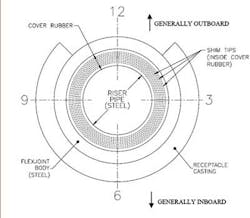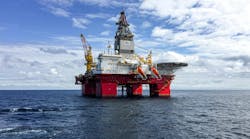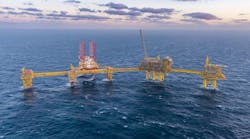Michael P. McGuyer
Seanic Ocean Systems
Steel catenary riser (SCR) flexible joints are a common way to attach anoffshore pipeline or flowline to a deepwater FPU. The primary function of a flexible joint is to suspend the SCR from the host platform, providing an articulated interface between the host and the SCR pipe. This allows for angular motion between the host platform and the SCR, thus reducing the bending moments in the upper section of the SCR. Preventative maintenance and inspection of the flexible joints is necessary to ensure safety and reliability; however these tasks are complicated because they disrupt production, happen in challenging locations on the asset, require special tools, and have an awkward geometry all complicated by sea state marine growth, and shallow-water ROV operations.
The Flex Joint Cleaning Tool (FJCT) from Seanic Ocean Systems is designed for SCR flexible joints in deepwater developments to meet the inspection requirements of the flexible elastomeric element. The FJCT clamps around subsea SCR flexible joints with pipeline diameters ranging from 4 in. to 24 in. to clean and inspect the underside of the flexible joint flex element by removing excessive marine growth from the elastomer. Removal of the marine growth is necessary for optimal inspection of the molded elastomeric bearing. The tool allowed the operator to establish realistic life-cycle expectations for in-service SCR flexible joints. The FJCT allows the operator options to use various inspection cameras, 3D modeling, lasers, temperature probes, and cleaning tools. The FJCT has been successful in more than 100 cleanings and inspections in the field.
How it works
A few inspection methods relevant to the SCR risers can be performed at fixed intervals. These inspections are described as periodic inspections and event-triggered inspections:
- General visual inspection (GVI) by ROV
- Close visual inspection (CVI) by ROV
- CVI by divers (Flexjoint and spool)
- External NDE by divers
- Intelligent pigging for wall thickness, pitting, and cracks
- Flexjoint stiffness calculations
- Fatigue calculations, etc.
A few of the monitoring statistics are relevant to the integrity management of the production SCR flexible joints. These include:
- Pressure and temperature (sensors)
- Current (ADCP)
- Vessel motions (navigation and GPS)
- SCR stresses (strain gauges)
- Flexjoint angles (angular sensors)
- Visual observations (sheen in the water)
- Wind and waves (weather buoys).
Previous inspection practices do not address the underside of the flexible joint flex element. The FJCT focuses on the inspection of the flexible joint elastomeric bearing/elastomeric material. The inspection can be done while the flexjoints are in service, eliminating loss of production or disruption to facility operations.
The objective of the inspection is to obtain a visual record of each SCR flexible joint and to document any irregularities. The data for each SCR flexible joint will be assessed by the operator's integrity management department following the inspection process using high-definition (12 megapixel) still photos, high-definition video recordings, hand drawn maps of potential anomalies, and a 3D model for trending higher risk SCR FJs or those found to have surface anomalies.
Potential problems are identified by noting anomalies along the surface of the cover rubber flex element. It is common to have a uniform series of bumps or low amplitude circumferential rings around the surface of the cover rubber due to normal budging of the elastomeric pads due to riser tension and internal pressure. Anomalies would be characterized by cracks, large irregular bumps, tears, or extrusions in the cover rubber. The inspection measures any anomaly length, width, and protrusion if a 3D model is built, along with providing the location to assist with future flexible joint assessments.
All anomalies are observed and fully documented by HD photographs, HD video, and written commentary. Typical anomalies include merged bulge pattern, local irregular bulge pattern, local tear, localized pad extrusion, and large irregular bulges or extrusions.
Data is gathered through the various monitoring systems and design documents. Critical locations are elected and subjected to periodic or event-triggered inspections, maintenance, or repair (IMR).
The criticality or risk for all scenarios relating to SCR failure modes must be dealt with through periodic inspections.
Plus, there are other risks relating to SCRs. These include fatigue due to excessive vortex induced vibrations (VIV), cut or loss of choke control, spool flange leakage, asset exceeds design motions, dropped objects, riser clashing due to VIV, fatigue due to excessive vessel motions, loss of strake, fairings and marine growth, and damage to coating leading to corrosion.
The operations integrity management team probably will take the data reported, and with support from engineering, develop specific inspection procedures and an IMR schedule. These will be the guidelines on what inspections to do, how, and when.
Most SCRs are below the water line, and are in many cases are difficult to access for inspection. Special tools are typically required. Other types of inspections may disrupt production at a considerable expense. As a result, inspections must be optimized to combine as many activities as possible into a single operation and minimize disruptions to the operations, while meeting safety and integrity objectives.







